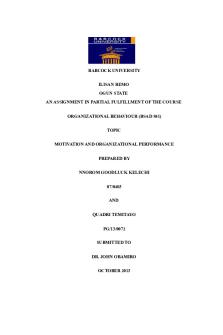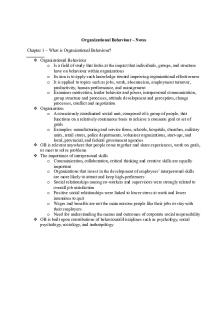Organizational behaviour paper questions answers PDF

| Title | Organizational behaviour paper questions answers |
|---|---|
| Author | maham khan |
| Course | Organisational behaviour |
| Institution | Quaid-i-Azam University |
| Pages | 7 |
| File Size | 202.7 KB |
| File Type | |
| Total Downloads | 106 |
| Total Views | 139 |
Summary
Organizational behaviour paper questions answers help students for their final exams.
It is a solved paper....
Description
Quaid-i-Azam University Islamabad Quaid-i-Azam School of Management Sciences
Final Exam / Fall 2020 To be filled by Teacher Course Code.: ……………………………Course Title:…………………….……………………………………………………………. Exam Duration:……….……………………………Date of Exam:………………………………………................................. Degree: ……………………………………….Semester:…………………………………. Section:…………………………………… Q. No.
1
2
3
4
5
6
7
8
9
10
Viva Marks Exam Obtained
Total Marks
Marks Obtained Marks in Words:
Name & Signature of teacher / Examiner:………………………………………………………………………………………
To be filled by Student Registration No.: 01422011002
Name: Maham Aziz
Answer the following questions. Briefly explain with example a). Referent power: A referent power of leadership is that leaders cultivate the respect and admiration of their followers in such a way that they want to be like them. In other words, different powers proceed by example. The referent power is based on the leader's behavioral model to demonstrate appropriate behavior and decision making. Employees observe the behavior of managers and they feel that their managers do in the same situation. In other words, what do you think managers do and you do the same; The manager will guide your behavior. You may not know that you are modeling your behavior after your manager's example. As you can imagine, this kind of power depends a lot on the employees ’confidence in their superiors and the development of the employee: how the employee can make decisions in certain work conditions. Takes time to develop trust and empower employees. As a result, referral authority may not function well in organizations with high employee turnover rates. It is important for the manager to be aware of the cultural differences when trying to use the referent power. For example: Kyle is the production manager for a large consumer electronics company. He has strong leadership within his subordinates, which comes from a positive attitude, strong subject matter knowledge, and a charismatic way of conveying ideas. Since Kyle took office, the company's production numbers have grown tremendously and the board of directors is very happy with what they are doing.
An external consulting firm evaluated Kyle's performance and concluded that he had developed a strong referral power throughout the organization, which created new opportunities for Kyle's career. If he continues to produce such good results, he is on his way to becoming the next CEO of the company. b). stages of group development: In 1965, a psychologist named Bruce Tuckman went through 5 stages of development: formation, storm, norming, performing, and adjourning. The stages start from the time that a group first meets until the project ends. A team cannot be expected to perform well from the time it is formed. Forming a team is like maintaining a relationship. In it, time, patience, support, effort and members often go through recognizable stages as they move into a united group as strangers with common goals.
1.Forming
2.Storming
5.Adjourning
4.performing
3.Norming
1. Forming stage: The first phase of group development is the formation phase. This phase presents a time when the group is just beginning to come together and is described with anxiety and uncertainty. Members are judicious in their behavior, motivated by their willingness to be accepted by all members of the group. Conflicts, disputes, misunderstandings and personal opinions are avoided even as members begin to make impressions of each other and gain an understanding of what the group will do together. Typical results of the forming stage include understanding group goals, determining how teams are organized and responsible, and discussing key milestones or phases of goals. The group contains an approximate project timeline, outlines general group rules, including when to meet, and gives you an overview of the resources available to the group. At this point, group members learn what to do, how the group works, what is expected and what is accepted. 2. Storming stage: The second stage of group development is the storming stage. The storming phase is where disputes and contests culminate because the group members now understand the work and the group members as well as the general understanding of the group members. At this stage, dominant members of the group emerge, while less conflicting members remain in their comfort zone.
Questions about leadership, rights, rules, policies, norms, responsibilities, structure, evaluation criteria and reward system usually arise at the stage of turmoil. These questions need to be answered so that the group can move on to the next stage. 3. Norming stage: In this step, the group becomes fun and enjoyable. Group interaction is much easier, more cooperative, and productive, with weighted give and take, open communication, bonds, and mutual respect. If there is a dispute or disruption, it is relatively easy to resolve, and the group gets back on track. Group leadership is very important, but the facilitator can step back and let the group members take the initiative and move forward together. 4. Performing stage: Once the group realizes its needs, it can move on to the third stage of the group's development, the rationing stage. This is when the group really gets closer. At this stage, the morale is high as the group members actively recognize the skills, abilities and experience that each member brings to the group. A sense of belonging is established, and the group focuses on the purpose and goal of the group. Members are flexible, interdependent and trust each other. Leadership is divided and members agree to adapt to the needs of the group. 5. Adjourning stage: This phase of the group can be confusing and usually arrives after the task is successfully completed. At this point, the project ends, and the team members look in different directions. At this stage, the team is viewed in terms of its well-being rather than the conditions it manages through the initial four stages of its growth. c). The calm waters Metaphors: Until recently the metaphor of calm water dominated the views of practicing managers and scholars. The current model for dealing with change in calm water is illustrated by Kurt Levine in his description of three stages of the change process. According to Lewin, successful change requires unfreezing the status quo,changing to a new state, and freezing the new change to make it permanent. Stability can be seen as a state of equilibrium. Melting is necessary to get out of this balance. This can be done in three ways:
To increase the driving force to move away from the current situation. To reduce the binding force that prevents movement from the existing equilibrium state. You can combine two methods.
Exhibit the change process: unfreezing, changing, freezing Once the unfreezing is complete, the change can take effect automatically. However, merely introducing changes does not guarantee that they will be implemented. Therefore, the new situation should be frozen again so that it can be maintained over time. If this last step is ignored, the change is likely to be short-lived and employees will return to a balanced state. The purpose of re-assembling the whole state of equilibrium is therefore to stabilize the new situation by balancing the drive and endurance forces. See how Lewin’s three steps process acts as a barrier to the organization's balance. The stagnation is broken, and a change is needed to restore the new state of balance. This theory may be
appropriate as a metaphor for relatively calm waters, as the description of these types of oceans that current managers must navigate is becoming increasingly obsolete. This metaphor takes into account the fact that the environment is uncertain and dynamic. For example: To get a feel for what change management would be if you had to constantly maintain limits, imagine that you are attending college and their courses vary in length, so when you sign up you don't know if the course will last for 2 weeks or 30 weeks. In addition, the instructor can complete the course at any time without any advance notice. If it's not too bad, the class period changes every time - sometimes it's 20 minutes, sometimes it's 3 hours, and the time for the next class meeting is set by the instructor during the previous class. Oh, there's more. All tests take place unannounced, so you should be ready for it at any time. To be successful in this college, you need to be incredibly flexible and be able to respond quickly to every changing environment. Students who are too methodical or slow-moving do not survive.
Qno.3 case study 1. Describe the elements of ROWE. What do you think might be the advantages and drawbacks of this program? A results-only work environment (ROWE) is a human resource management strategy in which employees are paid for results (outputs) and not for the number of hours worked. ROWE means that employees are rewarded for results, not activities, allowing leaders to focus on actually driving business results. There are 4 fundamentals for ROWE to succeed:
Employees must understand what their role is in the company. Employees must understand that they are accountable to employees. What is the measure of success? Employees must understand the consequences of failing to meet the prescribed measure of success.
Advantages:
Increased productivity Reduced voluntary employee turnover and Increased level of engagement for people Reduces the level of stress and overwork of employees. This makes employees feel stronger and more responsible for their results. It establishes autonomy and allows employees to be held accountable for what they do or not.
Disadvantages: Many employees can take advantage of their freedom to do the job just to survive, while others can contribute more to the organization. This will create an unfavorable work environment and leave some employees to work. In addition, managers will find it difficult to establish discipline by seeing how they are pulling the weight of their employees. The process is interesting and will work in a less controlled environment; However, maintaining an employee’s productivity can be difficult due to the employee’s ability to visualize the product.
2). Using one or more motivation theories from your course, explain why you think ROWE works. The program consists of many motivational principles, Theory Y - giving the employee more discretion than what they do in their work and making the task more difficult, setting a goal - as long as the conditions there give the employee a goal. Allow maximum participation in the sorting process. Work, then employees accept the goal and achieve it. Expectation Theory - This program uses some aspects of setting goals, creating expectations from employees and setting results. The result-only work environment (ROWE) is one in which the actual work is emphasized. "Most employees are inspired by one of David McClelland's principles." Excel about success and set of standards. "N-ach theory, or the need for achievement, is the desire to do something better or more efficiently than before. It is particularly relevant in the world of work. Employees." Achievement theory will also require a team member to receive recognition and critical feedback. An employee using this motivational principle will also determine a person. Smart, Achieved Goals. This motivational theory would explain ROWE because it assesses employees by their performance, results or output. 3). What might be the challenges for managers in motivating employees in a program like this? Motivation refers to the process by which a manager empowers, guides, and assists an employee in achieving a goal. As a manager, it can be difficult to manage employees with whom you do not communicate often. To ensure the completion of tasks, a manager must establish a level of trust in employees. This requires a change of culture from the manager's point of view, as the manager needs to be creative in how the workflow is managed and employees are motivated. The challenge for managers who use the ROWE concept will be that managers need to communicate frequently with staff to encourage them. It's hard to encourage employees you don't often interfere with. Another challenge is the changing nature of each employee's needs which creates challenges for the manager when it comes to motivating employees under the ROWE program, as employees may have needs and expectations at some point. Miscellaneous because is a rare conversation. Of the workplace. Their needs change and confrontation with others may end as they do their work in different environments unlike previous times when employees work in the same environment for up to 40 hours per week. 4). Does this sound like something you would be comfortable with? Why or why not? It is something I’d be more comfortable with because many students I think should report a preference for this type of arrangement. Yes. Rowe is something you can be comfortable with. ROWE or Results Only Work Environment, which is a pioneer in focusing on measuring results and employee outcomes rather than measuring the number of hours worked by employees. with me, is that ROWE is not a question of schedule. It makes me feel comfortable because I don't have to follow the schedule all the time. ROWE employees did not count the number of hours worked, but instead focused on doing their job, no matter how many hours or how many hours they took. For me, work is something you do, not a place you have to go, so ROWE is about increasing productivity because it is about reducing the burden and burden on employees by insisting that they spend a minimum number of hours on site. of work.
5) What's your interpretation of the statement that "Work isn't a place you go - it's something you do" Do you agree? why or why not? Work is based on activity and work. This is not a place because it is a safe place to work. So, I guess it doesn't matter where you work, just how you work. The flexibility of some workers allows them to work with enthusiasm. Example: If a marketer from a promotion agency sits in a room and holds a meeting to find a new idea, but it doesn't really help, it's hard to do. Therefore, I think the Rao program will help them find new ways to promote their products in attractive ways. However, this type of program is not suitable for all industries. Also, a large number of employees confirm their contribution to their employer based on the time they spend, not on effort. The king of this job does not help the company achieve its goals if the employees can sit in their place and wait for the shift to end before leaving. As employees realize that the company is focused on their work, they will realize the benefits of losing focus on time and space. Qno.1 where does the work of specialization fit in to the organizational designs? Using this contextual information………….? Every company must adhere to its organizational structure from the beginning. The organizational structure is based on authority and authority rules and obligations, and a typical corporate structure that ignores the way a company receives information. An effective organizational structure ensures that the enterprise implements the right operational procedures and ensures that the organization achieves its goals. Organizational experience is a decision when it comes to job specialization, also known as the division of labor. As shown in the figure, when unmolded, the power is significantly reduced, and labor is required. Allows managers to complete complex tasks and divide them into smaller tasks that are more accurate and can be performed by individual employees. These workers play their role effectively and successfully over time. Therefore, every employee of the company can be a professional. Especially useful for making works. Imagine a production line where each employee completes one step in the production process. For example, "maham set up frames, edited slides, and painted objects." All tests are complete, and the product is ready to ship. Dividing these measures into individual workers makes it much easier. After all activities and production stages of individual employees have been completed, they are complete and ready for sale. The effect is much less effective and takes longer. Along this curve, organizations can increase staff, allowing more employees to divide their work into specific positions, reduce responsibilities, and develop and specialize in one core area of expertise. Can be transformed into. This is the basic educational principle when a person first tries to edit a particular task. The longer you spend training and practicing, the better and more effective you will be. According to this curve, as an organization increases its workforce, more employees can divide work into few positions and perform fewer tasks and are able to develop and specialize in the same core expertise. It is a basic principle of learning when a person first attempts to modify specific tasks. The more time you spend practicing or training, the better the person will be successful and efficient....
Similar Free PDFs
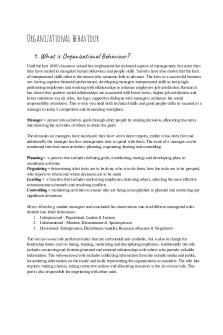
Organizational behaviour
- 67 Pages

Organizational Behaviour
- 2 Pages
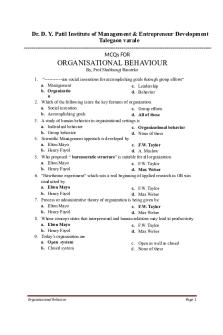
Organizational Behaviour mcqs
- 27 Pages
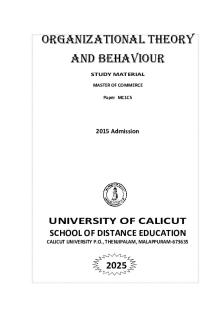
Organizational theory and behaviour
- 186 Pages
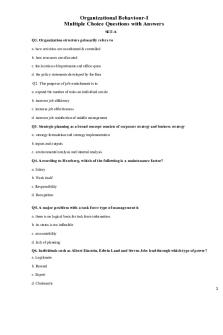
Organizational Behaviour MCQ SET
- 20 Pages
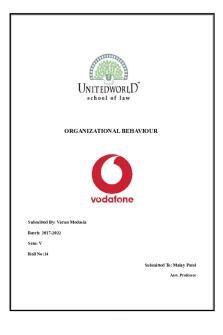
Organizational Behaviour Project
- 15 Pages

Chapter 2 ORGANIZATIONAL BEHAVIOUR
- 23 Pages

Organizational Behaviour Glossary
- 17 Pages
Popular Institutions
- Tinajero National High School - Annex
- Politeknik Caltex Riau
- Yokohama City University
- SGT University
- University of Al-Qadisiyah
- Divine Word College of Vigan
- Techniek College Rotterdam
- Universidade de Santiago
- Universiti Teknologi MARA Cawangan Johor Kampus Pasir Gudang
- Poltekkes Kemenkes Yogyakarta
- Baguio City National High School
- Colegio san marcos
- preparatoria uno
- Centro de Bachillerato Tecnológico Industrial y de Servicios No. 107
- Dalian Maritime University
- Quang Trung Secondary School
- Colegio Tecnológico en Informática
- Corporación Regional de Educación Superior
- Grupo CEDVA
- Dar Al Uloom University
- Centro de Estudios Preuniversitarios de la Universidad Nacional de Ingeniería
- 上智大学
- Aakash International School, Nuna Majara
- San Felipe Neri Catholic School
- Kang Chiao International School - New Taipei City
- Misamis Occidental National High School
- Institución Educativa Escuela Normal Juan Ladrilleros
- Kolehiyo ng Pantukan
- Batanes State College
- Instituto Continental
- Sekolah Menengah Kejuruan Kesehatan Kaltara (Tarakan)
- Colegio de La Inmaculada Concepcion - Cebu


